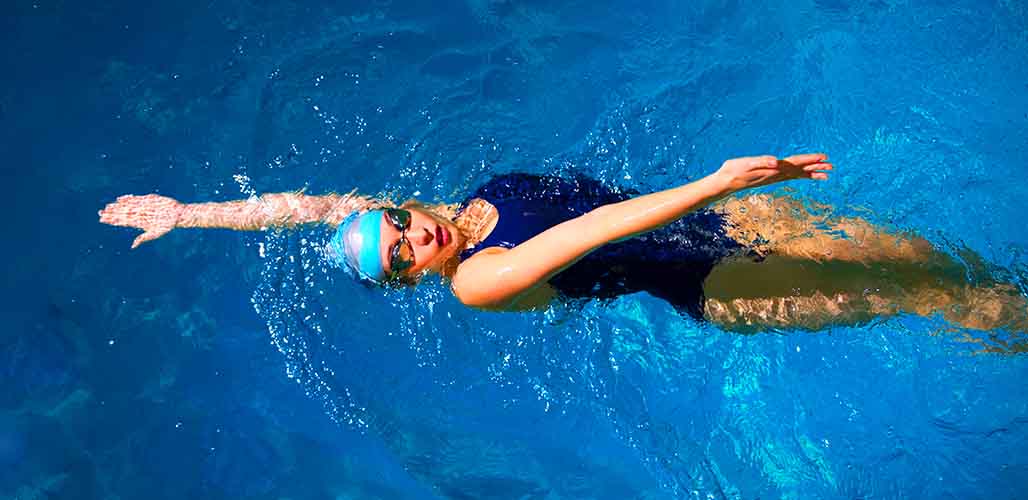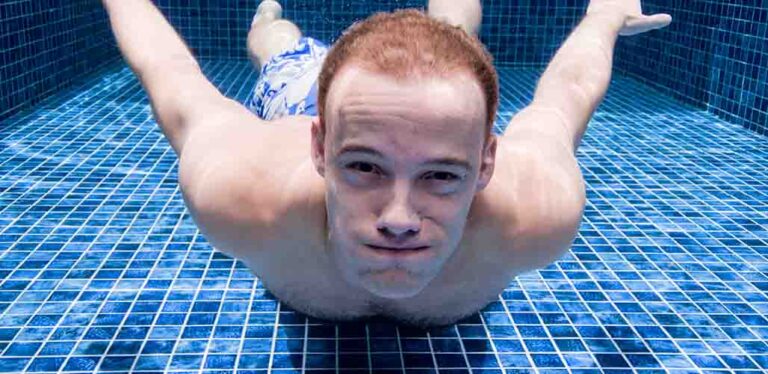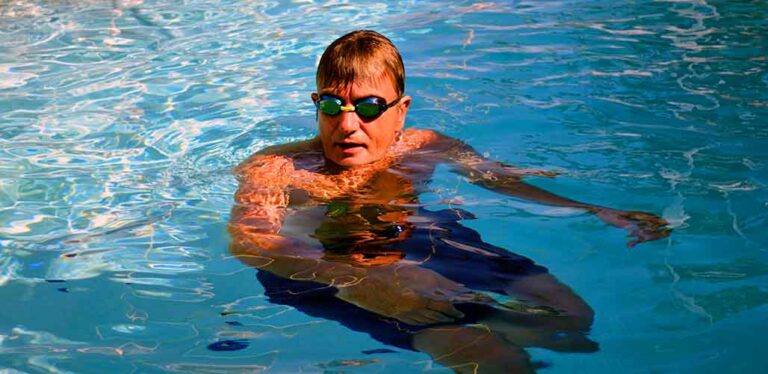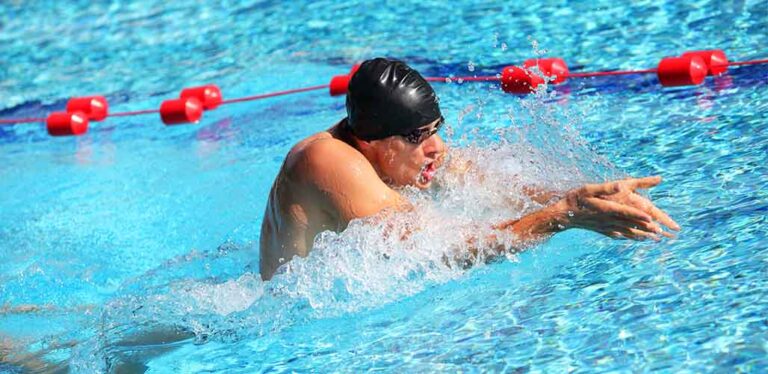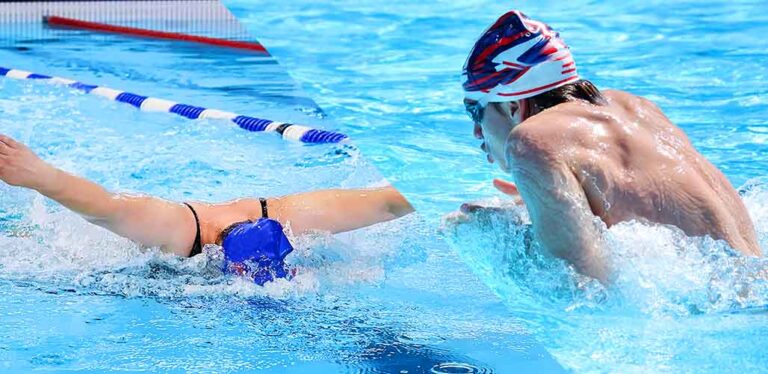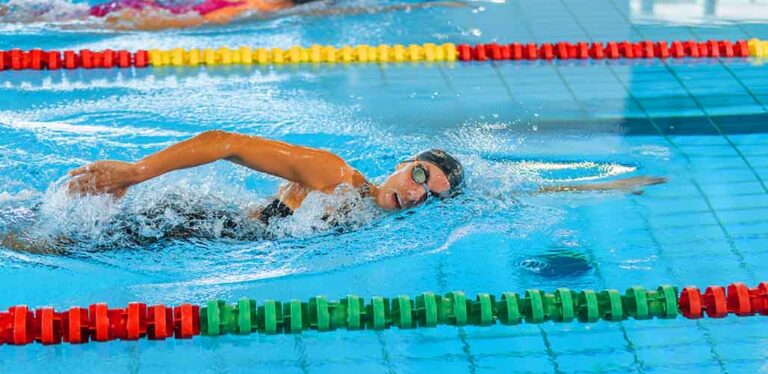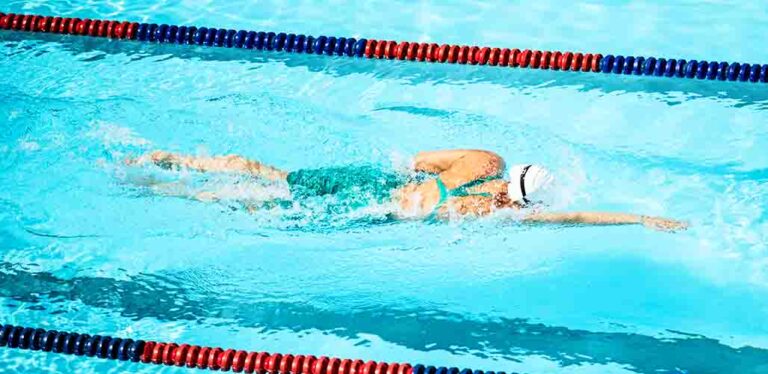How To Improve Your Backstroke – Expert Tips From An International Swimmer
There are a few simple actions you can take to improve your backstroke. Better form and movements of the arms,body posture and kick can turn this basic stroke into a real powerhouse technique in the water.
Contents
The backstroke, along with freestyle, is one of the two alternating strokes in swimming. It is perhaps the stroke where body alignment and core stability matter most, and while every single stroke is hard to master, the backstroke can be challenging at every level.
The fact that you spend most of your time at the pool swimming on your stomach, the change to swimming on your back can make a few of the details tough to master.
This guide is designed to help swimmers of all levels, from novices refining their skills to seasoned swimmers seeking to optimize their performance. We’ll go over every detail, focusing on body alignment, arm and leg mechanics, and incorporating effective drills. Once you piece together everything in this guide, you’ll be on your way to mastering the backstroke.
Streamline: The Foundation of Backstroke
Like every stroke in swimming, a good backstroke begins with maintaining an efficient body position. In swimming, it always comes down to the streamline.
The goal with backstroke is lying flat on your back in the water, aligning your head with your spine, and extending your body all the way to your toes. You’ll want to keep your hips near the surface and your legs extended and relaxed. Proper body alignment minimizes drag and maximizes stroke efficiency.
And while it sounds easy in concept, once you get in the water you’ll realize just how difficult it is to maintain. So how do you do it? Let’s break it down.
Core Engagement: The Key to Stability
Ask any coach: a strong core is essential for stability and efficiency. That goes for any stroke, and back isn’t any different.
Engaging your core muscles and visualizing your body as a long, straight line as you do your arm pull is paramount.
You’ll need to automate the core engagement so that with each cycle your strength doesn’t come from the arms and legs alone. Better yet, your core is your center, and you should feel as if you’re pulling with it.
Head Position: The Balancing Act
Along with your core, head positioning will help you swim in a straight line.
Keep your head aligned with your body, looking directly upwards. Avoid lifting your head too high or dropping your chin too low, as this can disrupt your body alignment and increase drag. You want it to be in perfect alignment with your spine.
Body Roll: Powering Your Stroke
Initiate the roll from your shoulder, and don’t forget to keep your core engaged, allowing your body to rotate with each arm stroke.
If you don’t roll your body you’re missing out on a fundamental portion of propulsion and body alignment.
Arm Mechanics: The Propulsion Engine
There’s no denying, while the core and the body roll are a huge part of propulsion, the arms are the motor.
Entry and Catch:
As your arms come out of the water, ensure they’re relaxed. After extending your arm above your face, you want to enter the water pinky-first. As your hand enters the water, bend your elbow and initiate the catch by pushing the water behind your butt.
Also, remember to keep the body roll in mind. As you push the water, engage your core and rotate in the opposite direction to maximize each stroke.
The catch should be firm but not forceful. Your hand should be relaxed all the way through, maintaining a continuous propulsion flow. The less you fight with the water, the better.
Pull and Recovery:
The thing with backstroke is that the pull is more of a push. It is the only stroke where you’re pushing the water away from your center.
With your elbow bent, pull your arm down towards your hip, maintaining the bend in your elbow until the very last moment. As your reach the hip area you need to extend your arm to generate every last bit of propulsion you can.
Simultaneously, the other arm recovers over the water.
Alternate these arm movements in a fluid motion, keeping body rotation as your north star throughout the pull phase to maximize propulsion and minimize resistance.
Hand Position
Your hand position during the pull is critical for an effective backstroke. Keep your hand relaxed, fingers slightly spread apart, and your palm facing outward. This allows you to catch more water and generate more propulsive force.
Some beginners tend to believe that cupping your hand is the way to go. Avoid it. Cupping your hand or gripping the water too tightly is a no-go, as this will mean more drag, less power, and more energy expended.
Tempo and Timing
These two can make or break your stroke. You can be technically proficient, but if your tempo or timing is off, it can throw everything off.
Synchronize your arm movements with your body roll for an efficient backstroke. Time your arm strokes so that one arm is entering the water as the other completes the pull phase. This ensures a continuous power flow and reduces any pauses in your stroke.
Experiment with different tempos to find a rhythm that suits your natural stroke style. One thing to remember, though. Don’t try to drive your tempo up using your arms, or you’ll find yourself spinning.
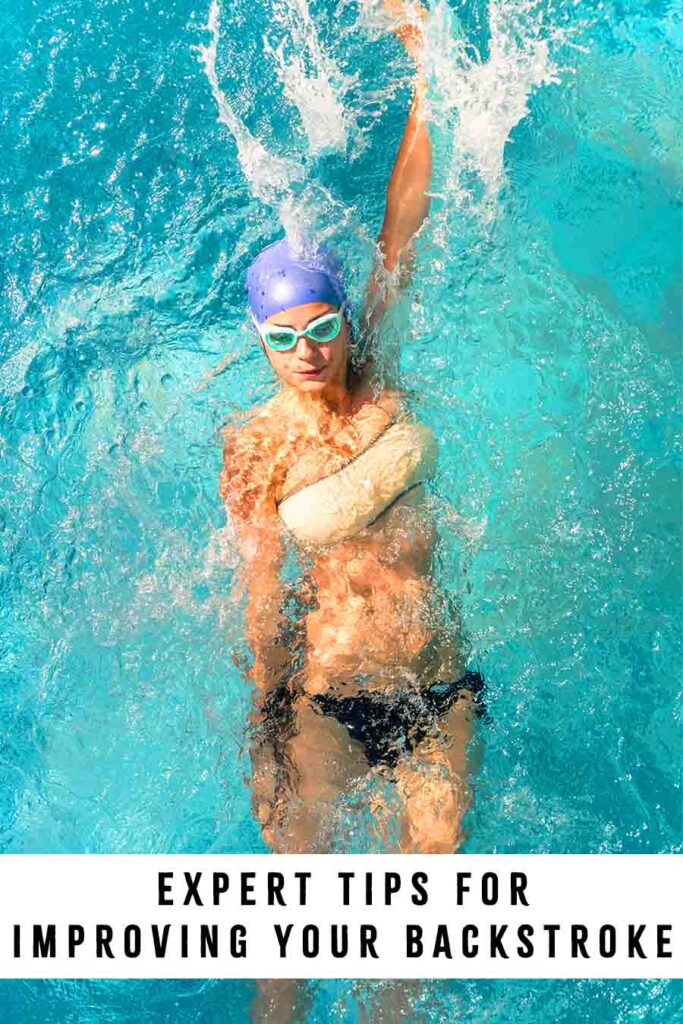
Better Kicking Mechanics To Improve Your Backstroke
So how do you better manage your tempo? That’s where kicking comes in.
Flutter Kick:
The flutter kick is the primary leg movement in backstroke.
Initiate the kick from your hips, keeping your legs close together and your feet relaxed. As one leg kicks up, the other should kick down. Try to remember this, as one of the most common mistakes swimmers make is only kicking in one direction. By doing so, you won’t neglect nearly 50% of the propulsion from each kick.
Generate propulsion without excessive splashing. Your feet should not come out of the water.
Maintain a steady and consistent kick throughout your stroke and adjust your arm tempo accordingly.
Underwater: The Fifth Stroke
Believe it or not, the fastest you’ll ever be is when you’re dolphin kicking underwater after a wall. That’s why, among the elites, it’s called the fifth stroke.
Incorporating underwater dolphin kicks into your backstroke can make you faster over any length.
During the underwater phase after the start or turns, execute a series of fluid dolphin (or butterfly) kicks while keeping your body in a perfect streamline. Your arms should be completely straight and tucked behind your head with your hands all the way out in front.
Dolphin kicks involve a simultaneous movement of both legs while generating propulsion from the core. Every swimmer does it differently. Some like to undulate from the chest, others from the stomach, while some prefer to start from the hips. Try every variation and see what feels comfortable for you. There’s no right or wrong answer here, just remember to engage the core and experiment.
Drills To Improve Your Backstroke
As with everything, practice makes perfect, so here are three exercises you can do to take your backstroke to the next level.
One-Arm Backstroke
This is perhaps the most basic backstroke drill you can try. It’s perfect for beginners and advanced swimmers alike.
Performing the backstroke with only one arm can help refine your technique and enhance your pulling motion. Focus on maintaining balance and a streamlined body position while engaging your core muscles.
This drill allows you to focus on the pull and recovery of a single arm, emphasizing proper hand and elbow position, and can help detect any imbalances you have between your right and left sides.
Pro tip
Don’t tell your coach we said this but try pulling on the lane line. Alternate one normal pull with one assisted pull. Replicate the motion you use when pulling on the lane line and you’ll develop a much more efficient stroke.
Backstroke Balance Drill
Practice floating motionless on your back with perfect body alignment. Once you find your balance start kicking and rotating your body with your arms along the body while keeping the head still.
This drill develops core strength and body awareness, allowing you to maintain stability throughout your backstroke. Focus on keeping your head, spine, hips, and legs in a straight line, and engage your core to maintain balance.
Start by practicing this drill for short durations and gradually increase the time as you become more comfortable.
Pro tip:
Once that becomes easy, try filling a water cup or bottle and placing it on your forehead. Try to keep the cup from falling as you swim backstroke. This is the ultimate drill to discover how much your head position and body alignment need work.
Ankle Flexibility
While it’s not exactly a drill, improving your flexibility will do wonders for your kick and overall stroke.
Flexible ankles are crucial for an effective backstroke kick. Increasing range of motion allows you to generate more propulsion with each kick, making your backstroke faster and more efficient.
You can improve ankle flexibility in a variety of ways. Using fins, stretching your calf muscles, or simply sitting on your knees with your feet under your butt and gently forcing the ankle to stretch.
Pro tip:
If you need a challenge on that last one, try placing a towel under your toes for added difficulty.

